How to operate in the information environment is subject to intense debate. Identifying and tracing multiple narratives on complex security problems enhances understanding for contemporary military operations. As an illustration, this article discusses ‘narrative net assessments’ of US and al-Qaida narratives in the 1990s, and Iranian and Israeli narratives on military power projection in Syria between 2016 and 2018. The cases generate different types of insights; on counter-productiveness of statements and actions, and the need to shift the level of analysis. Both demonstrate the value of the comparative logic of the applied methodology – Analysis by Contrasting Narratives (ACN).
A traditional focus of policy makers, military commanders and their intelligence analysts lies with the events and actors in the physical domain (for example through geospatial analysis, hot spot maps, or social network diagrams), while underemphasizing the specific ideational context (the ‘why?’).[1] This can be illustrated by the core tenets of the widely adopted intelligence related ‘ICA’ model of ‘threat’ as a multiplicative function of ‘estimated intentions’, ‘estimated capabilities’ and ‘observed activities’. More traditional approaches are not obsolete, however, there is a need for analytical tools that can make better sense of the ideas people hold and share, also in the virtual (cyber) domain. This may concern either genuine perspectives, deliberate disinformation, or conspiracies, for example.

A soldier from the Israel Defense Forces looks out over Syria. Israel’s narratives about power projection in Syria constitute one of the cases discussed in this article. Photo Israel Defense Forces
Contemporary military operations require awareness of and cooperation with an exceeding number and mix of actors, and the significance of the information domain is brought more and more to the forefront. Illustrative are NATO’s adoption of Strategic Communication and subsequently the elevation of information as a warfighting function equal to fires and command and control.[2] However, while dealing with dynamic strategic and operational environments, policy makers and military commanders also have to take (political) constraints on action perspectives into account. Mission mandates both enable and constrain as they identify and focus on actors and themes, prioritizing a particular perspective. Particularly for military commanders, reflecting on such constraints can be counterintuitive to the hierarchical relationship. So in spite of increased awareness of the information domain there is still a risk of underemphasizing the impact of such (political) problem framing.
Rather than focusing on ‘information as a weapon’ or instrument to be used in synergy with specific kinetic operations, this article stresses the need for a broader reflexive approach on the construction of complex security issues and related military missions. How do different (types of) narratives – including one’s own strategic narrative – represent and shape people’s views and actions, and influence other narratives? Analysis by Contrasting Narratives (ACN) is a relevant methodology that seeks to produce a ‘narrative net assessment’ to facilitate answering this: multiple relevant narratives are defined and interactions traced, as their development is mapped.[3] While ACN was primarily developed as an academic methodology, elements of it, whether applied in a structured or less structured manner, can also aid military decision makers at different levels in understanding the context within which they operate.
This article discusses two ACN cases that each produced different types of insights. Research on US and al-Qaida narratives in the 1990s showed the significance of their interaction for the growth of al-Qaida as organization and network. An analysis of Iranian and Israeli narratives between 2016 and 2018 on power projection in Syria revealed the tripartite (or inconsistent) nature of the national Iranian narrative, and omission of significant events in the Iranian and Israeli narratives. The multifacetedness of the ‘Iranian narrative’ entails an important finding, not a shortcoming of the analysis: it highlights how an analysis different than at the national level is required. Such findings can inform ex durante reflection on the meaning of the projection of (Western) military force in the region.
Analyzing narratives
Narratives can be understood as an aggregation of texts on events, actors, time and locations into a storyline. They represent interpretations and not only describe, but over time can also change culture, norms, people’s identities, or physical circumstances. It is important to understand a narrative can have multiple, very different audiences that each interpret events or texts differently: some are sympathetic to grievances or problems, while others are also inspired to act (violently). Yet, conversely, others might feel threatened by these same texts or the broader narrative and react, for example by promoting counter-narratives. The same speech, image or event can thus also become part of different narratives, as they are interpreted in different contexts. Tracing this ‘multi-consequentiality’ is important to enhance understanding: what is true, for whom, in what context, motivating what action? This also implies the need for reflexive self-critique on one’s own strategic narrative to better understand how root causes, circumstances and agendas interact.
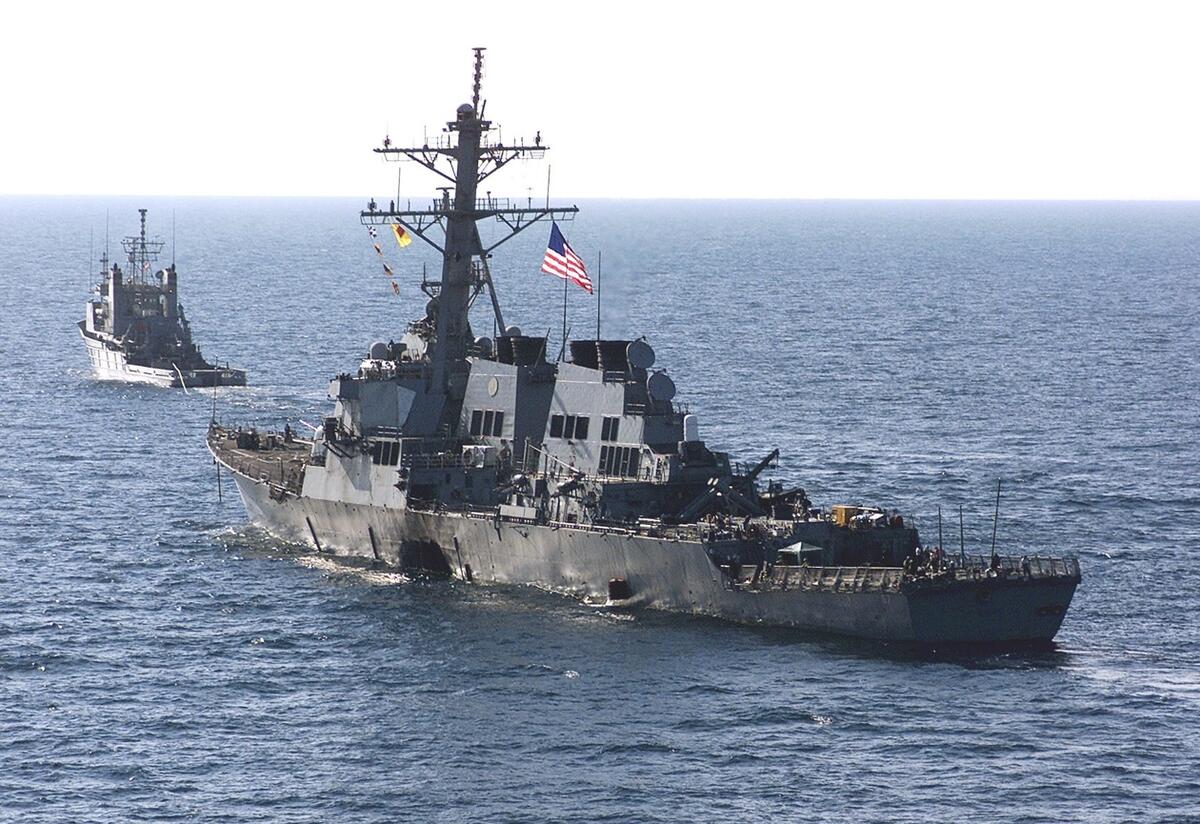
The USS Cole is towed away from Aden into the open sea, after al-Qaida attacked the ship in October 2000. Photo U.S. Department of Defense, Don L. Maes
Analytically, a distinction can be made between narratives associated with those that have power to influence the security problem (macro narratives), and potentially critical accounts of actions and events by those possibly unable to exert direct influence (or less influence) on situations (micro narratives). Studying the latter further improves sensemaking, as they can highlight tensions and inconsistencies in the framing of events in macro narratives. Often, for each narrative, a particular group of actors or individuals is central for producing the most relevant texts. However, in case of online conspiracies and leaderless movements, for example, one can also trace the use and spread of particular symbols or names (e.g. the term ‘QAnon’, ‘anonymous’, or the picture of a white mask, or a yellow ribbon).
Based on an initial idea of relevant events for a complex problem, ACN proceeds in two phases. First, by selecting and analyzing texts (public statements, documents, articles, images, signs) associated with the identified key actors various macro narratives take shape. It can be productive to highlight elements of threat construction (securitization efforts), problems, solutions (or critique on it).[4] This is revealed in frames, metaphors, stereotypes, etcetera. How do these relate to norms, conventions, social identities, roles and power? What can or cannot be said by whom, to whom, in what way? And how does this fit a wider socio-cultural or ideological background context?
Second, the development of the various macro narratives is compared and contrasted. What are the links? What different audiences are reached by the narratives, and what effects does this have? Are audiences establishing or changing in and through the narratives? Do statements and events over time influence the background context? How relevant are all narratives for power relations? Does threat articulation in one narrative lead to a similar dynamic in other narratives, or other forms of polarization, marginalization or domination? Insights gained aid to assess or anticipate (counterproductive) effects of policy initiatives or military operations. Possibly they can generate new options by reconsidering the level, scope, or focus of analysis.
US and al-Qaida in the 1990s
For understanding al-Qaida’s emergence or growth in the 1990s it is particularly insightful to analyze its narrative, primarily shaped by Osama bin Laden’s statements. It was fundamental for al-Qaida’s development and transformation as an ideology, movement, network and organization.[5] In contrast to other types of discourse analysis, ACN has brought the benefit of tracing how its development paralleled or linked to the US institutional terrorism narrative. The event timeline included Bin Laden’s comprehensive speech and article in 1996, the World Islamic Front 1998 declaration, the 1998 Embassy bombings in Africa and US missile strikes, the foiled millennium plots in the US and the attack on the USS Cole in Yemen in 2000. The analysis was further enhanced by including a micro narrative, constituting of investigative reports by journalists such as Robert Fisk and Peter Bergen. As they were able to interview Bin Laden, meet with US officials, and report relatively freely about it, their perspective placed both macro narratives in a different light.

All narratives were situated in different social contexts. Representing the state, US President Bill Clinton and other government officials were following Western democratic institutional and political conventions. Clinton’s position of power allowed him to reach a large national and international moral audience. For use of force beyond limited military strikes he was dependent on the consent of his formal audience; the US Congress. Hence, securitization efforts (declaring al-Qaida a threat to national security) could be relatively easily identified in to letters and speeches. Textual analysis was limited to relevant fragments as, in contrast to Bin Laden, Clinton was concerned with many more pressing national security issues; such as the Kosovo crisis, nuclear proliferation in Asia, or the Israeli-Palestinian conflict.
A pivotal moment in all narratives was the bombing of the US embassies in Kenya and Tanzania in August 1998. In response Clinton ordered military strikes against Bin Laden’s organization in Sudan and Afghanistan.[6] He chose not only to mention Bin Laden by name, but also to quote his threatening language in his statements. Still, the legitimacy and effectiveness of the missile strikes became contested, particularly in the Arab and Muslim world. The Sudanese target was possibly a medicine factory and the Afghan strike had failed to hit any al-Qaida leaders.
At the time, Clinton was also involved in a personal sex scandal and later impeachment trial. His personal and political problems limited the momentum of his efforts to frame Bin Laden as an international terrorist and ‘the world’s problem’.[7] Nevertheless, from an American perspective Clinton tried to do everything he could to counter the threat: economic sanctions would prevent any dealings by Bin Laden with American companies, the highest reward ever at the time (US$5 million) was issued for information on Bin Laden, and later he was also placed on top of the FBI’s most wanted list. However, even American news reporters noted at the time how the measures were mostly symbolic. There were practically no economic ties, and high rewards seldom generated useful information on international terrorists.
Around the millennium celebrations, the threat of terrorism was clearly articulated in the US narrative. The US government sought to reassure its citizens the threats were under control, also demonstrated by several arrests in the US and Jordan. In September 2000, as the USS Cole was bombed in Yemen, Clinton was nearing the end of his term. He commented in more moderate words on the attack, refraining from an additional securitization effort. In light of the upcoming elections, he even sought to emphasize ‘hope’ and ‘prosperity’, and stated America was ‘not at war’.[8] In secret, however, Clinton had given the FBI, CIA and the military the authority to go after Bin Laden and al-Qaida.
The al-Qaida narrative contributed to a partial ideological transformation of the Salafi jihadist social practice or context. Instead of agitating against a local ‘infidel’ ruler, a ‘far enemy’ was to be confronted. When looking at events from Bin Laden’s perspective it becomes clear how significant his securitizing rhetoric and US (counter)actions were: both shaped the narrative, Bin Laden’s social role and identity, and al-Qaida as an organization.
Initially, several factors removed momentum from Bin Laden’s securitization efforts. He had always been respected for his eloquent use of classical Arabic. Yet there were reservations about his religious credentials among several sympathetic Muslim audiences. Moreover, in the early 1990s there was disagreement among Bin Laden’s followers over whether it was wise or fruitful to (rhetorically) target a far enemy. Later, co-signatories of a fierce ‘World Islamic Front declaration’[9] in 1998 also turned out not to represent their associated Salafi jihadist organizations. Some were even expelled from their organizations because of their support to Bin Laden. Finally, the embassy bombings in Africa caused a lot of unintended civilian casualties and Bin Laden initially denied involvement.

Osama bin Laden records a video message in 1996. He was very concerned about creating the right image in the media, often using maps, a captured Soviet kalashnikov and religious books in the background to emphasize his status and message. Photo ANP, Polaris Images
However, the balance shifted and momentum started to build after the US missile strikes in Sudan and Afghanistan. Furthermore, the 1998 US sanctions mirrored the boycott of American goods Bin Laden had declared himself years earlier. The immense reward merely emphasized how he and his followers had rejected capitalism and strived for an ascetic life. Clinton’s statements and the FBI listing finally provided the recognition Bin Laden had sought for years. A noteworthy facilitating condition was also the development of satellite television technology. It enabled Bin Laden to comment on Al Jazeera before a pan-Arab audience on world events, such as the US bombing of Iraq. Bin Laden was able to link to broader anti-US themes and audiences, reaping more understanding, sympathy and support.
Illustrative of the difference in perspective is how religious verses and poetry were omitted by the US Counter Terrorism Center at West Point in English translations of a 1996 epistle by Bin Laden.[10] Thereby also changing the meaning of the text into a more frontal assault on the US, underemphasizing grievances against the Saudi monarchy. In contrast, the micro narrative emphasized how Bin Laden’s statements contained a broader message, and were at times ambiguous, contradicting or shifting definitions of the ‘zionist crusader’ enemy. It also presented US policies as missing their intended impact in the Middle East.
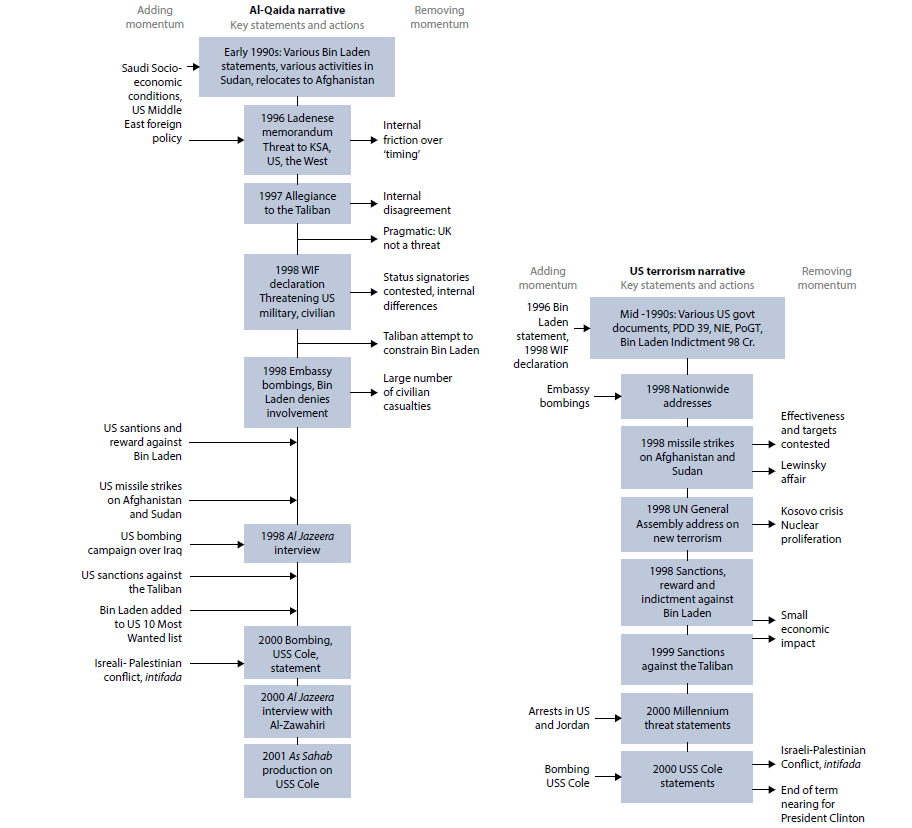
Figure 1 Overview of the al-Qaida narrative and the US institutional terrorism narrative, each combining significant events, broader trends or general contextual aspects. Factors adding or removing momentum to dominant (securitization) framing are depicted left and right
Obviously, a more in-depth analysis cannot be provided here (for example also on the role of the Taliban),[11] but it is clear there was a polarizing dynamic between the two macro narratives. Overall, the al-Qaida narrative and accumulation of securitization efforts served to establish Bin Laden’s identity, al-Qaida’s power base and organizational structure. For the US government, its narrative was more of a continuation of pre-existing institutional roles, social identity and power. Even though Clinton chose to moderate his tone in public regarding al-Qaida at the end, the initial peak of strong securitization efforts had had detrimental effects. The US narrative decreased internal friction and disagreement in Al-Qaeda. In part, the analysis in the next case also highlights the significance of understanding internal friction.
Power projection in Syria 2016-2018
Both Israeli and Iranian employment of military means in Syria takes place in the context of a highly complex conflict with a multitude of local, regional and global actors involved, all with their own interests. Contrasting the Iranian and Israeli narratives between 2016 and 2018 in this regard sheds light on the nature and effects of these perspectives and the various audiences involved.[12] In that period several significant events took place and statements were made: Iranian and Hezbollah drones and even an Israeli F-16 were shot down over the area, Israel bombed Iranian targets in Syria on a regular basis, and addresses were given before the UN General Assembly and the Munich Security Conference. Both the Israeli and Iranian leadership had to take different foreign and domestic audiences into account in articulations of threats and security.
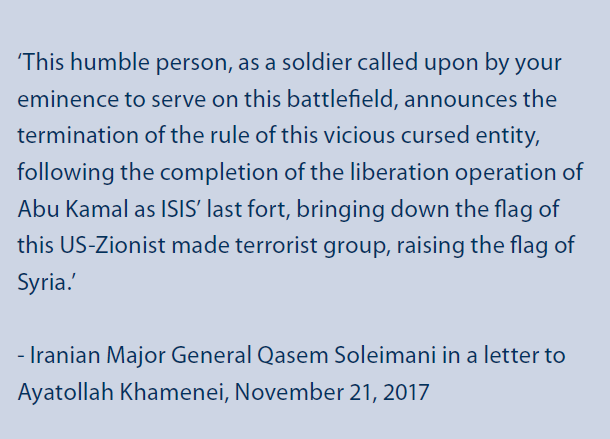
The research showed how the Iranian defence and foreign policy narrative was in fact multisided, reflecting the socio-cultural, political and religious context, and complex governance system of the country. Foreign Minister Zarif de-emphasized Iran’s military involvement in Syria in an attempt not to further securitize the issue, repeating that only Iranian ‘advisors’ were present in the country at the invitation of the Syrian government. Supreme Leader Ali Khamenei straddles what outside of the Iranian context is usually regarded as two social practices: being both the highest political (and military) and religious authority in Iran. The audience of his texts was primarily domestic, in contrast to Foreign Minister Zarif’s statements, which were aimed at an international (diplomatic) audience. This difference was reflected in Khamenei’s use of significantly more belligerent language. He blended religious and political themes, utilizing the frames of ‘martyrdom’ and ‘sacrifice’, which was reinforced by a state policy of honouring individual casualties with state funerals or propaganda in public places.
The military leadership of the Islamic Revolution Guard Corps (IRGC) used language in line with Khamenei. In November 2017, for example, IRGC-general Qassim Soleimani wrote a public letter to the Supreme Leader on the event of the ‘defeat of ISIS’, when Iranian supported militias drove ISIS from a Syrian-Iraqi border town. Soleimani’s wording partly reflected the Supreme Leader’s use of language (e.g. ‘poison of Zionism’ and ‘dark and dangerous conspiracy’).[13] Khamenei replied with a similar public letter of his own. Another general, from the Iranian Air Force, boasted about the number of conducted drone strikes in Syria. Overall, the language utilized by top IRGC officers was the most direct or explicit on military power projection in Syria among the various Iranian narrative strands. More than Zarif and Khamenei, Iranian President Rohani was forced to navigate between addressing a foreign and a domestic audience, making the aggregate of his texts less consistent.
Nevertheless, neither the domestic nor the foreign audiences seemed to resonate with the various Iranian narratives as intended. Although religiously motivated volunteers did fight in Syria, the war did not appear to be popular with the general public in Iran. Illustrative of this are public protests in December 2018-January 2019 in the country against corruption and economic issues, but also against support for other countries. Slogans heard included ‘Let go of Syria, think about us’.[14] The narrative discrepancies between Rohani, Zarif, Khamenei and the IRGC-leadership show there was no consistent overarching Iranian narrative.
Compared to Iran the Israeli executive power is less distributed. During the period under review, Benjamin Netanyahu combined the roles of Prime Minister and Foreign Minister. A second – less prominent – key player was Avigdor Lieberman, Minister of Defence until November 2018. Netanyahu engaged in securitization efforts in which he equated the threat posed by Iran and its proxies towards Israel with Sunni extremist organisations such as ISIS. In several instances, Netanyahu used frames that resonated with Western and US audiences (e.g. ‘Iranian curtain’) to emphasize the threat that Iran posed. He also repeatedly mentioned Israel’s ‘red lines’ calling them ‘thick and clear’.[15] The term red lines is a charged one in the Syrian context. It was used by several actors, but most famously by US President Barack Obama; calling the use of chemical or biological weapons by the Syrian regime a red line. Here, ‘thick and clear’ was a subtle reference to the perceived inability of Obama to stick to his word, as well as an effort to underline Israel’s retaliatory strategic posture.
Both Netanyahu and Lieberman upped the ante after January 2018 in terms of frequency and strength of their wording. In February Netanyahu gave a speech at the Munich Security Conference about Iranian involvement in Syria, and compared Iran with Nazi Germany. He also drew a parallel between the international Joint Comprehensive Plan Of Action (JCPOA)[16] for Iran and the 1938 Munich Agreement. Netanyahu continued to utilize these and similar frames in speeches over the next few months, leading up to the US withdrawal from the JCPOA in May 2018. International media coverage of the Iranian-Israeli conflict over activity in Syria spiked through the first half of 2018, reaching a wider audience than before, particularly in the western hemisphere.
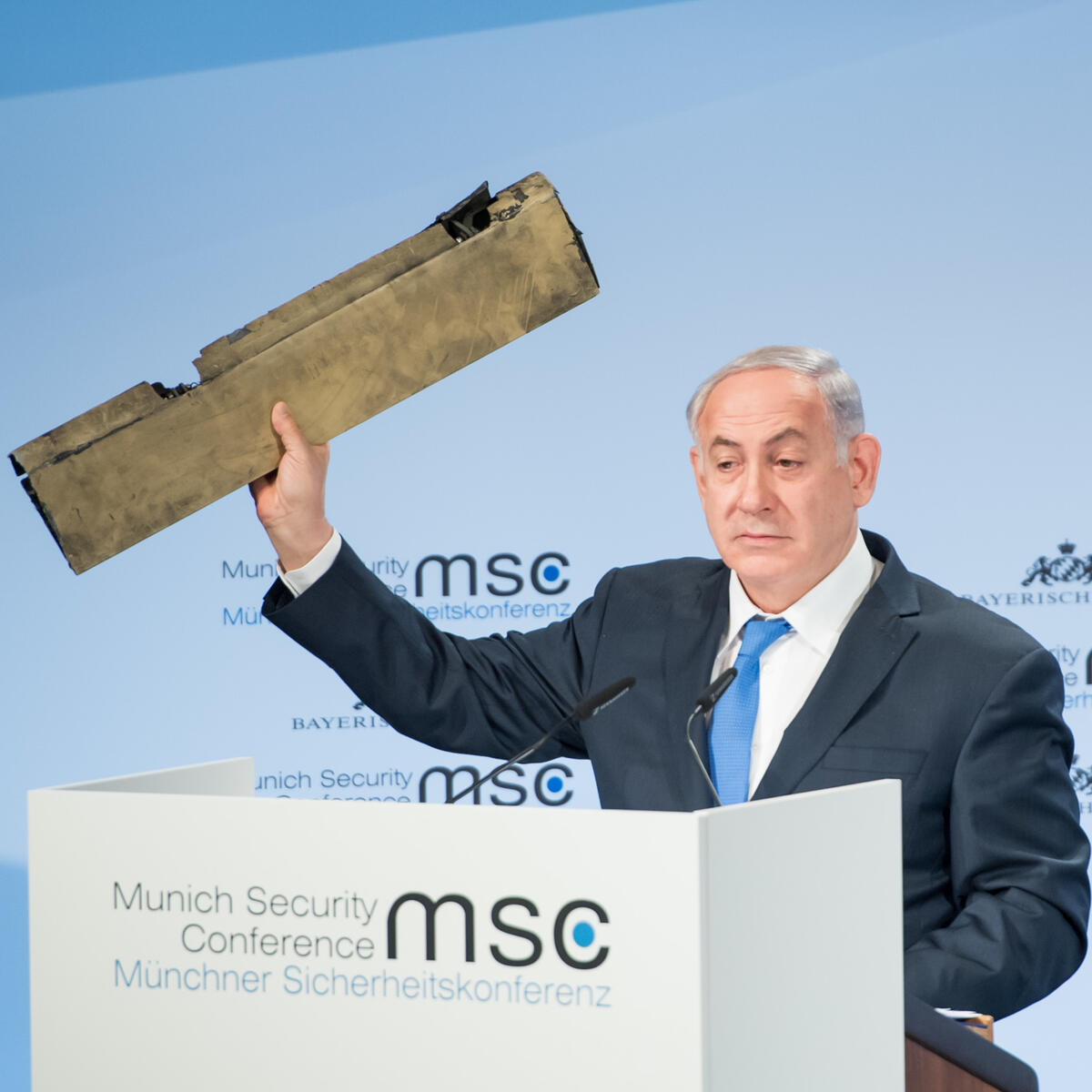
Underlining the Iranian threat, at the Munich Security Conference (2018) Netanyahu held up a fragment of a shot down Iranian drone. Photo Munich Security Conference
Although the meaning of the Israeli narrative did not change substantially over the research period, the increased intensity starting early 2018 followed developments such as the November 2017 capture of the Syrian-Iraqi border by Iran-backed militias mentioned above. The idea that this uptake in Israeli emphasis on Iranian activity was caused by the opening up of an alleged ‘Iranian land route’ through Syria is consistent in timing. However, Netanyahu used the Syria issue to highlight the bigger concern of Iran’s threat to the broader region, rather than limiting the focus to local military developments in Syria. Moreover, two coinciding issues external to Syria were also relevant: US withdrawal from the JCPOA, and domestic corruption charges against Netanyahu. Although Netanyahu claimed these allegations would ‘come to nothing’, the connection between Netanyahu’s securitization efforts and the corruption charges was drawn by several commentators over the next months, removing momentum from Netanyahu’s securitizing efforts.
Iran, and Zarif in particular, campaigned for the US to remain within the JCPOA. Zarif sought to emphasize how the country didn’t pose a threat in the Middle East. This limited the extent to which Iranian interests in Syria could be emphasized or securitized. It would draw specific attention to Iranian military support for a regime deeply unpopular in the West. In this light, emphasizing Iranian involvement in Syria was beneficial for Netanyahu. However, not all of the frames he presented resonated well within the international community, such as the comparison he made between Iran and the Nazi regime.
In terms of interaction, it was mostly Iranian generals who responded to the Israeli narrative in the form of – sometimes veiled – threats, while Zarif, Rohani and Khamenei rarely commented directly on statements by Netanyahu or Lieberman. Iranian national news media reported on Netanyahu’s ‘ridiculous show’ in Munich, with no significant international reproduction of their reporting.[17] On the Israeli side, Netanyahu and Lieberman generally latched onto the most extreme instances of framing within the Iranian narratives. As such, the statements and texts (e.g. by Khamenei and IRGC leadership) aimed at the Iranian domestic audience, facilitated threat articulation in the Israeli narrative. Religious and military wording was used to discredit Iranian intentions and expose its ‘true nature’ before an international audience.
A micronarrative is provided by Aymenn al-Tamimi, a British researcher and publicist. In his writings the significance of the ‘land route’ was downplayed, questioning the extent to which increased Israeli attention for power projection in Syria in 2018 was triggered by the local events of late 2017.[18] Al-Tamimi focused on developments in Syria that were (conveniently) largely ignored in the greater Israeli and Iranian narratives. Netanyahu and Lieberman only commented on developments in Southern Syria when asked, and did not comment on Eastern Syria. In turn, the Iranian narratives did not even mention Israeli support to the armed opposition in Syria, which is remarkable considering the potential propaganda value, as this support could easily be framed as meddling in the internal affairs of a sovereign state or aiding terrorists. All in all, the analysis showed the need for understanding and prioritizing the subnational level of analysis of Iranian narratives, and illustrated how events – even those with military(-strategic) significance – were excluded from the narratives.
Conclusion and Reflection
The case examples have shown how ACN can generate different types of insights, for example on multi-consequentiality of statements and actions or reconsidering the level of analysis for sensemaking. When explicitly tracing the effects of one’s own strategic narrative on other relevant narratives, awareness is raised regarding the potentially counterproductive effects of policies or military operations. The degree to which a narrative is fragmented indicates the need to shift to a lower level of analysis. In both a strategic and operational environment this facilitates improvement of diplomatic, key leader or audience engagement strategies. Just as significant as what is said, is also the unsaid. What is omitted in the narratives of adversaries and other key actors, and what potential does this have?
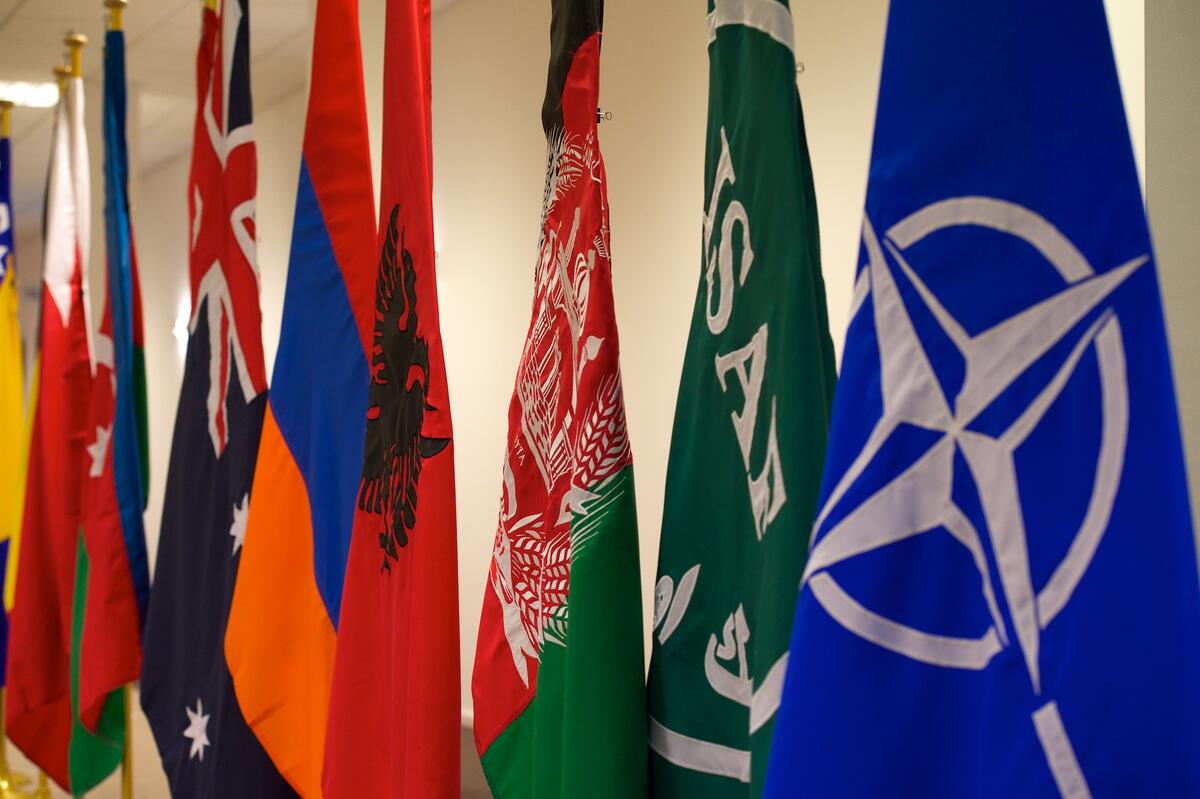
Flags of NATO and its member states. Given that most military operations are multinational in nature it would be interesting to, for example, consider differences between problem definitions and political mandates of the various contributors. Photo NATO
ACN focusses on the gist of narratives in light of a particular security problem. For intelligence professionals, military commanders or policymakers, applying academic methodologies in full is seldom feasible. Yet there already lies value in embracing more of the comparative logic of ACN. It is about seeking to increase perspectives and understanding of framing practices through a ‘narrative net assessment’, and using this to strengthen sensemaking and ex durante feedback mechanisms on the projection of military force. The language-centric approach can be implemented to various extents, producing either indicative or more fine-grained and solid conclusions. In any respect, adopting this thinking and analytic focus on narratives encourages further self-reflection on one’s own policies and operational plans for complex security problems. It can lead to more critical questioning and review of problem framing and some of the political constraints put on action perspectives.
Given that most military operations are multinational in nature, and sometimes exist in parallel to other combat, peace keeping or stability operations, it will be interesting to consider differences between political mandates of the various contributors, underlying definitions of the ‘problem’, and experiences on the ground. For example, in Afghanistan, how have policies and actions by the International Security Assistance Force (ISAF), the US-led Operation Enduring Freedom, the Afghan government, the Taliban, or numerous other groups varied and related?[19] How united are the Taliban? Or for Mali; what is the multi-consequentiality of statements and actions related to the French counterterrorism operation Barkhane, the Malian interim government, the Tuareg and various other peace deal signatories or local groups, and the narratives of contributors to the United Nations Multidimensional Integrated Stabilization Mission in Mali (MINUSMA)?[20] Rather than defining or finding ‘the truth’ integrally making sense of ‘the most relevant truths’ becomes the aim to enhance understanding for contemporary military operations.
[1] J. David Singer, ‘Threat-perception and the armament-tension dilemma’, in: The Journal of Conflict 2 (1958) (1) 94.
[2] Joris van Esch and Simon Hirst, ‘How to operate in the information environment. A practitioner’s perspective from 1 (German/Netherlands) Corps’, in: Militaire Spectator 189 (2020) (9). See: https://www.militairespectator.nl/thema/operaties/artikel/how-operate-information-environment.
[3] For a more detailed description and full academic discussion, see Peter de Werd, US Intelligence and Al Qaeda. Analysis by Contrasting Narratives (Edinburgh, Edinburgh University Press, 2020). A summary is also included in Richards J. Heuer Jr. and Randolph H. Pherson, Structured Analytic Techniques For Intelligence Analysis, 3rd edition (Washington, DC, CQ Press, 2021) 285-289.
[4] A suggested framework for analysis is ‘securitization’. Its efforts involve a) an initiating securitizing actor defining b) a referent object (those threatened), c) referent subject (the threat), d) and the necessary measures proposed to counter the threat, before one or several audiences.
[5] De Werd, US Intelligence and Al Qaeda.
[6] Ibidem, 122-130; William J. Clinton, ‘Address to the Nation on Military Action Against Terrorist Sites in Afghanistan and Sudan’ August 20, 1998. See: https://www.presidency.ucsb.edu/documents/address-the-nation-military-action-against-terrorist-sites-afghanistan-and-sudan.
[7] William J. Clinton, ‘Remarks to the 53d Session of the United Nations General Assembly in New York City’, September 21, 1998. See: https://www.presidency.ucsb.edu/documents/remarks-the-53d-session-the-united-nations-general-assembly-new-york-city.
[8] William J. Clinton, ‘The President’s Radio Address’, October 14, 2000. See: https://clinton.presidentiallibraries.us/items/show/13254.
[9] For example, see Gilles Kepel and Jean-Pierre Milelli, Al Qaeda in its own words, translated by Pascale Ghazaleh (Cambridge MA, Harvard University Press, 2008) 53-56. In various English translations this declaration has often incorrectly been classified as a ‘fatwa’, implying a different, more universal socio-cultural and religious status.
[10] Osama bin Laden, ‘Declaration of War’, 1996, translated by CTC West Point, as in De Werd, US Intelligence and Al Qaeda, 61-73.
[11] See De Werd, US Intelligence and Al Qaeda.
[12] Frans Boersma, ‘The battle of words on power projection in Syria: comparing Israeli and Iranian narratives’, unpublished master’s thesis (Breda, Netherlands Defence Academy, 2019).
[13] Official website Ayatollah Khamenei, ‘Gen. Soleimani congratulates Ayatollah Khamenei and Muslims on ISIS termination’, November 21, 2017. See: http://english.khamenei.ir/news/5283/Gen-Soleimani-congratulates-Ayatollah-Khamenei-and-Muslims-on.
[14] Boersma, ‘The battle of words’, 15; National Council of Resistance of Iran, ‘Angry Protesters chant: “Let go of Syria, think about us” No Gaza, “No Lebanon, my life for Iran”’, July 3, 2018. See: https://www.ncr-iran.org/en/video/angry-protesters-chant-let-go-of-syria-think-about-us-no-gaza-no-lebanon-my-life-for-iran/.
[15] Jerusalem Post, ‘Netanyahu: Iran responsible for more than 80% of Israel’s security concerns’, March 6, 2017. See: https://www.jpost.com/israel-news/benjamin-netanyahu/netanyahu-iran-responsible-for-more-than-80-percent-of-israels-security-concerns-483354.
[16] The JCPOA is a 2015 agreement between Iran on one side and the P5+1 and European Union on the other, easing economic sanctions in return for Iranian concessions regarding its nuclear program.
[17] Mehr News, ‘Netanyahu’s ridiculous show in Munich’, February 18, 2018. See: https://en.mehrnews.com/news/132257/Netanyahu-s-ridiculous-show-in-Munich.
[18] Aymenn Jawad al-Tamimi, ‘The Iranian land route to the Mediterranean: Myth or reality?’, American Spectator, August 22, 2017. See: http://www.aymennjawad.org/20190/the-iranian-land-route-to-the-mediterranean-myth; Aymenn Jawad al-Tamimi, ‘Iran in Syria’, The Economist, October 5, 2017. See: http://www.aymennjawad.org/20537/iran-in-syria; Aymenn Jawad al-Tamimi, ‘Iran in Syria: “Cognitive empathy” and interests’, Syria Comment, May 13, 2018. See: http://www.aymennjawad.org/21168/iran-in-syria-cognitive-empathy-and-interests.
[19] Specifically regarding securitization, see for example Holger Stritzel and Sean C. Chang, ‘Securitization and counter-securitization in Afghanistan’, in: Security Dialogue 46 (2015) (6) 548-567.
[20] See for example Stephen Harmon, ‘Securitization Initiatives in the Sahara-Sahel Region in the Twenty-first Century’, in: African Security 8 (2015) (4) 227-248, or Clingendael, ‘Decentralisation amidst hybrid governance: The case of northern Mali’, CRU Policy Brief, June 2020.